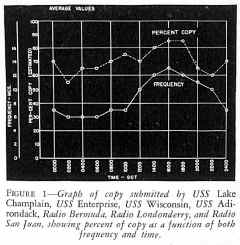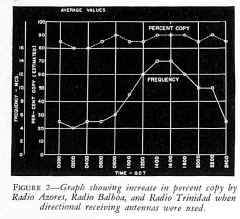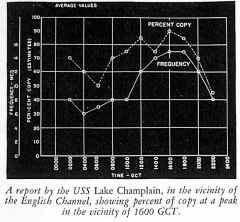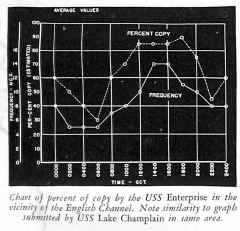




The Chief of Naval Operations has just released a report on a subject which should be of great interest to both
Technicians and Radiomen throughout the fleet. Is it feasible and practicable to replace manually operated Fox circuits with
automatic systems on board ship? Many factors enter into the final conclusions and recommendations arrived at by the tests which were conducted
between 10 and 15 December, 1945.
Elaborate plans and arrangements were necessary for a completely comprehensive test in which all the points in question could be
checked and all possible obstacles brought to light. Immediately following the regularly scheduled International Morse
Washington Fleet Primary Broadcast, a retransmission was made, using frequency-shift-keyed radio-teletype code. The prime
purpose of this test was to obtain data to provide a basis for the study and investigation of the possibility of replacing the
manual copy of these broadcasts with radioteletype. It is a matter of record that radioteletype has been used on ship-shore
circuits with a certain degree of satisfaction in the Pacific. This test was primarily made to study the problems involved in
the north Atlantic area where conditions are not as favorable.
Radioteletype has several advantages as well as some disadvantages. It affords a speed in the vicinity of 54 words per minute
after deducting time required for such functions such as line-feed, carriage-return, and figures, and on the assumption that no
repeats are necessary. A reduction in the number of operating personnel may result. It permits semi-automatic relay from the
guardship by VHF/UHF radioteletype. It permits automatic decryption as well as automatic tape perforation while encrypting. But
it increases shipboard weight unless the operating table and typewriter are eliminated, and it requires specialized maintenance
personnel, with complete reliance upon continuous performance of a mechanical system.
During the tests the first retransmission began at 1432 GCT on 10 December 1945 and the last retransmission at 1825 GCT on 15
December 1945, using the regular Washington Fox frequencies of 4045, 8090, 12135, and 16180 kc. The very low frequency of 18 kc
was not keyed during the tests. At the time the tests were being conducted, approximately thirty ships in all fleets and a
number of shore stations were equipped to receive frequency-shift-keyed radioteletype transmissions. The shore stations in the
Atlantic area were requested to participate, simulating shipboard receiving conditions as nearly as possible; that is, to
utilize shipboard-type receiving antennas rather than directional diversity equipment. Some ships in the eastern Pacific were
invited to participate in order to provide information on the quality of reception in that area and at that distance. These
ships were in ports on the West Coast. Their findings contributed beneficially to the tests. Of the total number of ships
equipped to receive frequency-shift-keyed radioteletype transmissions, the following six contributed to the test: USS Lake
Champlain (CV-39), USS Enterprise (CV-6), USS Wisconsin (BB-64), USS Adirondack (AGC-15), USS Iowa (BB-61.), and USS Missouri
(BB-63).
In addition to the ships, shore radio stations at Argentia (NWP), Londonderry (NST), San Juan (NAU), Trinidad (NYS), Azores
(NBP), Balboa (NBA), and Bermuda (NWU) assisted materially by sending in their radioteletype copy.
A careful analysis of the copy and notes submitted by the above stations was made. Although some of the shore stations did not
simulate shipboard receiving conditions, their copy was useful in that it was analyzed separately for comparison. The copy made
by the shore stations that did simulate shipboard conditions was combined with that submitted by the ships for the ultimate
analysis. To insure a thorough check, various combinations of receivers, converters, and antenna assemblies were used at
different locations. The Lake Champlain and Enterprise employed an FRC Converter, Vertical and Whip Antennas, and RBC receivers,
while the Adirondack substituted a horizontal antenna for the whip. The Wisconsin used horizontal antennas with the FRC and RBC
combination. The shore stations employed combinations of converters with inverted-L vertical and horizontal antennas.
Londonderry and Bermuda used receivers of the AN/FRR and AN/FRR-3A type respectively, while San Juan employed an HQ-120-type
receiver. Balboa, Azores, and Bermuda used directional antenna systems with various combinations of converters and receivers.
Because of the many variables encountered, the analysis was made on a very broad basis. Accurate determination of exact percent
copy was very difficult due to the nature of the text material transmitted. In view of the problems, the analysis was made on an
estimation based on the following categories:
(a) 20 to 60 percent copy-Unreadable
(b) 60 to 80 percent copy- Fair
(c) 80 to 90 percent copy- Good
(d) 90 to 100 percent copy- Very Good
Figure 1, a graph of percent of copy versus frequency and time, submitted by ships and shore stations simulating shipboard
receiving conditions over a 24-hour period of each day, indicates a minimum average copy of 55 percent and a maximum of 85
percent. A total over-all average of 75 percent was made by these stations. No adjustment was made for longitude of the
receiving stations, which should have a smoothing effect on the curves. It may be seen from the graph that the best average copy
was made between 1600 and 1800 GCT. It is apparent that the percentage of copy was far below an acceptable standard. It should
be noted that many ships recorded perfect copy for several hours each day, but the categories used and the averaging with other
ships holds the maximum to 85 percent.
The frequency curves on these charts do not reveal much information since, due to the constantly-changing ionosphere propagation
conditions during the test, plus local conditions, the best frequencies as well as frequency-diversity reception were utilized.
They do indicate, however, that frequencies were selected in close agreement with the predictions in Navy Registered
Publications Memoranda, and that poor copy coincided with the necessity to use lower frequencies while best copy was made when
the higher harmonics could be received.
A graph of the copy obtained by the shore stations that employed directional antennas is shown in figure 2. It will be noted
that the minimum average copy obtained was 80 percent, and the maximum was 90 percent (between 1400 and 1800 GCT), an average of
85 percent.
Comparison of figures 1 and 2 indicates graphically the difference in average copy as the result of the use of directional
antennas for reception. Here again, solid copy was received by many stations for the best hours but when averaged with poorer
copy, difficulties encountered on days of ionosphere storms and the use of broad categories in the averaging process, the figure
was kept from being 100 percent in the best hours. These results compare with a low-power, point-to-point circuit, because the
transmitting antennas were not directional.
Many problems were encountered during the test, the more important ones being low signal-to-noise ratio, fading, interference
from other stations, round-the-world echo, existing ionospheric and atmospheric conditions, interference from shipboard radar
and radio transmitters, shipboard noise level, and various printing difficulties.
It was borne out conclusively by the participants in the test that a signal level at least 20 db above the noise level passing
through the filters was necessary in order to attain a high percent of copy. By high percent of copy is meant an acceptable
ultimate minimum of 99 percent perfect copy with unbunched errors. The statement has often been heard that it is possible to
make perfect copy on a frequency-shift-keyed circuit when the signal cannot be heard by ear. Very likely the comparisons were
made under unequal conditions, such as the failure to use, for reception by ear, an audio filter which is as selective as the
audio filter in the FSK receiver converter.
After several weeks of experience with this equipment, there was no doubt left that acceptable copy could be made manually on
the NSS Fox circuit when only extremely poor copy could be made by radioteletype. On the other hand, when there was difficulty
with the manual circuits there never was a time when the radioteletype equipment had a chance of making any copy at all. The
signal definitely had to exceed the noise for teletype reception, whereas it did not for manual reception.
The problem of low signal level with respect to a high no1se level, although of long standing, was again proved to be the main
factor encountered. Frequency-shift keying has similarities to voice frequency-modulation since noise, both man-made and that
created by the elements, is mainly of an amplitude form, it has been claimed that it will not create as much interference to FSK
reception.
The participants in the test reported, from direct observation utilizing an oscilloscope to monitor the frequency-shift-keyed
signal, that the mark-space pattern would disappear when subjected to noise crashes. Simultaneously with this, the radioteletype
invariably printed errors. Many suggestions were made to increase in effectiveness and reduce the errors. These suggestions are
for increased transmitted power, the use of a wide-angle directive transmission, use of shipboard diversity reception, use of
frequency-diversity transmission and taking measures to reduce the noise level on board ship.
The effects of fading on the copy received by a station or ship is obvious, the result being misprints and unreadable garbles.
Reception at the bottom of fades is a measure of the reliability of the system. Most of the participants utilized a system of
space diversity reception with whip antennas or a combination of a standard wire antenna and a "whip" in order to reduce the
depth of fades. Frequency diversity reception was also utilized on numerous occasions to good advantage although it doubles the
vulnerability to interference, and was not always possible when one harmonic of the series was clearly superior.
Considerable interference was experienced as a result of echo. At times the round-the-world echo completely obliterated the
keying, making teletype copy impossible and manual copy very difficult. One of the main reasons for this in the FSK system is
the use of limiters in the receiver converter, which have the effect of leveling off the direct signal to the same volume as the
round-the-world signal One recommendation made was to rearrange the NSS antennas so that they will create less field strength on
a bearing of about 240 true, which probably can be done without making any material reduction in signal in the Atlantic
extending between Argentia and Balboa. The transmission of a fifth harmonic of the series may also provide a cure inasmuch as
this frequency may be less likely to carry both ways around the world. The echo phenomenon is reported by commercial companies
to be encountered regularly in this area in November through February from about 1300 to 1600 GCT. Careful observation of this
region on a globe will make clear the conditions that bring about round-the-world echo. It requires an approximately twilight
path both ways around the earth. This occurs when the great-circle path of the signal reaches a maximum northern latitude within
about five or ten degrees of the Arctic Circle, when the sun is about 90° from the Arctic Circle (midwinter), and when the
longitude of the sun is within an hour or so of the longitude passing through the northernmost latitude of the great-circle
signal path. In view of this fact, it is considered possible to design a " null" in the transmitting antenna pattern ashore so
that it will fall on the bearing that will create a larger difference between the "direct" signal strength and the "round-the-world" signal strength.
It was noted that 14 December was a particularly bad day insofar as ionospheric propagation conditions were concerned. All
long-range North-Atlantic communication circuits experienced operating difficulties on that day. Inasmuch as long-range high-frequency communication is solely dependent upon reflection from the layers of the ionosphere, the importance of this factor and
the difficulties experienced as a result of ionospheric disturbances, were recognized.
Considerable interference was experienced in various forms due directly to the elements. The radioteletype copy occasionally was
completely obliterated by interference caused by snow and sleet electrostatic discharges and
ordinary lightning crashes. Interference of this nature is expected in ordinary communications and is a problem of long standing. Although it is mainly of
an ampl1tude form, it does interfere with reception of frequency-shift-keyed transmission as explained previously.
A nominal amount of interference from radar pulses, spurious emissions from radio transmitters, key clicks, etc. was
encountered. Among forms of shipboard noise, ignition interference from aircraft on flight decks has been reported. In view of
this, it was recommended that new aircraft standards be set, giving consideration to interference suppression. Other noises such
as intermittent contacts between loose metallic bodies, and from many electrical accessories, was objectionable and action
should be taken to eliminate or drastically reduce it in order to lower the general level of shipboard radio interference.
As a result of the analysis of the test material submitted, it was concluded that the maximum overall percent copy obtained by
the participants is below the acceptable standards. Before automatic transmission and reception of the Fleet Primary Broadcasts
by radioteletype can be accepted, this system must equal or surpass the present manual system of transmission in fidelity and
reliability, producing not more than one percent errors during the least favorable hours of the day. On the basis of the
information and data obtained from this test, it is believed that the many problems encountered can ultimately be overcome to
the degree necessary to render reliability and fidelity, if aggressively attacked.
Figure 1 |
Figure 2 |
======================== |
 |
 |
 |